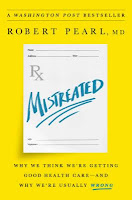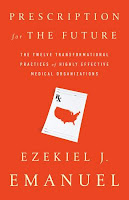Books to Get You Thinking
The past few years have seen much discussion on healthcare in the US and it is widely recognized that medical care here has become unaffordable and riddled with inefficiencies. The United States spends a fifth of its gross domestic product on healthcare—more than twice the average spent by any other developed country and yet its medical outcomes on many indicators of quality such as life expectancy, infant mortality, immunizations, and death from hospital-acquired infections are lagging behind those achieved by other industrialized countries. Despite the availability of sophisticated medical technology and advanced treatment, medical care remains inaccessible to many. Much of the recent discussion of proposed legislation lacks focus on measures to bring down the runaway prices that have become the hallmark of the American medical industry. The book selections this month address some of the core problems underlying the healthcare system in the US and their possible solutions. All books can be found in the Mercer County Library System!
An American Sickness: How Healthcare Became Big Business and How You Can Take It Back by Elisabeth Rosenthal
Elizabeth Rosenthal, physician and editor in chief of the nonprofit Kaiser Health News, offers an insightful perspective on the key problems underlying American healthcare and possible solutions to bring about an efficient and affordable system that works for all. Rosenthal argues that over the last twenty five years the medical industry has gradually become transformed from a patient-centered and caring occupation to a medical-industrial complex driven by profit. To understand the intrinsic problems of the healthcare system, the author feels it is necessary to recognize the unique nature of the medical market—it does not function as other commodities and services in a free market economy; nor does it allow an open market in healthcare to deliver efficient outcomes. Rosenthal provides fascinating examples that illustrate and identify ten different “economic rules of a dysfunctional medical market” that characterize and are unique to the US healthcare market. These include facets of the healthcare system that lead to surprising results—often more treatment and most expensive treatments prove most profitable, a lifetime of treatments prove more lucrative than providing a cure, drug prices are skyrocketing, marketing pays off more than focus on care, patients have no free choice, and there exists no fixed price for tests, procedures or uniformity in billing. Most importantly, the fact that ultimately it is human lives that are at stake allows “Prices [to] rise to whatever the market can bear.” In looking to future solutions, Rosenthal calls attention to the importance of having a fully engaged and empowered body of patients who ask the right questions about tests, treatments and referrals, and to an enhanced role of the government in preventing runaway costs and counteracting vested interests in the medical sector.
Mistreated: Why We Think We’re Getting Good Health Care—And Why We’re Usually Wrong by Robert Pearl
Robert Pearl, a physician and surgeon on the faculty of Stanford’s Medical and Business schools and CEO of Kaiser’s Permanente Medical Group for over fifteen years, brings with him both the skills of being a clinician and a leader in healthcare policy. The author has dedicated this book to the memory of his father, who died as a result of an avoidable medical error. An important question that the author explores in the book is why thousands of patients die each year from preventable diseases and medical errors. The central problem lies in the organization, structure and technological underpinnings of the medical care system in the US and in its leadership, system of payments and reimbursement. A huge potential for improvement exists in incorporating the use of modern digital technology to build an integrated and coordinated electronic records system where all the information and data about a patient is available in a single health record—this would enable physicians to make a more accurate diagnosis and implement a collaborative treatment plan for patients. Another aspect of the existing system that needs to be targeted is the integration of healthcare both vertically across primary, specialty and diagnostic care as well as horizontally within specialties. The author reinforces the importance of physician leadership in patient care and adopting a viable and equitable system of reimbursement that is based on patient outcomes and value created instead of the fee-for-service or volume-based payments that is currently in place. This would make healthcare more affordable, accessible and efficient.
Prescription for the Future: The Twelve Transformational Practices of Highly Effective Medical Organizations by Ezekiel Emmanuel
In this well-researched book, Ezekiel Emanuel, an oncologist and Chair of the Department of Medical Ethics and Health Policy at the University of Pennsylvania, provides a thoughtful perspective on targeting different areas of healthcare to eliminate existing inefficiencies and ensure delivery of high value care. The healthcare system as it exists today underperforms on many counts and has an excessively high cost structure. Emanuel bases his research on case studies of innovative medical establishments in the US that have adopted policies to improve patient experience and the quality of care dispensed while lowering overall healthcare costs. His research leads him to identify twelve different transformational practices that can be implemented and transferred from one medical organization to another in all the different regions of the country. One key element in achieving an affordable healthcare system is a comprehensive transformation of the patient care delivery system that would include the building of standardized protocols and effective chronic care coordination. This would include measures to reduce preventable complications and medical errors, ensure the ordering of the right tests and treatments and building a networked support system that helps patients adhere to the prescribed regimen. Additionally, removing unnecessary services that raise costs without improving medical outcomes and prescribing lower cost clinically equivalent services would help keep health care cost increases in check by eliminating waste. Such measures would require setting up the appropriate financial and legal environment surrounding medical practice—most importantly the transition from the existing fragmented fee-for-service model to a system that offers financial incentives for higher value care that encourages keeping people healthy through coordinated collaboration between all providers.
An American Sickness: How Healthcare Became Big Business and How You Can Take It Back by Elisabeth Rosenthal
Elizabeth Rosenthal, physician and editor in chief of the nonprofit Kaiser Health News, offers an insightful perspective on the key problems underlying American healthcare and possible solutions to bring about an efficient and affordable system that works for all. Rosenthal argues that over the last twenty five years the medical industry has gradually become transformed from a patient-centered and caring occupation to a medical-industrial complex driven by profit. To understand the intrinsic problems of the healthcare system, the author feels it is necessary to recognize the unique nature of the medical market—it does not function as other commodities and services in a free market economy; nor does it allow an open market in healthcare to deliver efficient outcomes. Rosenthal provides fascinating examples that illustrate and identify ten different “economic rules of a dysfunctional medical market” that characterize and are unique to the US healthcare market. These include facets of the healthcare system that lead to surprising results—often more treatment and most expensive treatments prove most profitable, a lifetime of treatments prove more lucrative than providing a cure, drug prices are skyrocketing, marketing pays off more than focus on care, patients have no free choice, and there exists no fixed price for tests, procedures or uniformity in billing. Most importantly, the fact that ultimately it is human lives that are at stake allows “Prices [to] rise to whatever the market can bear.” In looking to future solutions, Rosenthal calls attention to the importance of having a fully engaged and empowered body of patients who ask the right questions about tests, treatments and referrals, and to an enhanced role of the government in preventing runaway costs and counteracting vested interests in the medical sector.
Mistreated: Why We Think We’re Getting Good Health Care—And Why We’re Usually Wrong by Robert Pearl
Robert Pearl, a physician and surgeon on the faculty of Stanford’s Medical and Business schools and CEO of Kaiser’s Permanente Medical Group for over fifteen years, brings with him both the skills of being a clinician and a leader in healthcare policy. The author has dedicated this book to the memory of his father, who died as a result of an avoidable medical error. An important question that the author explores in the book is why thousands of patients die each year from preventable diseases and medical errors. The central problem lies in the organization, structure and technological underpinnings of the medical care system in the US and in its leadership, system of payments and reimbursement. A huge potential for improvement exists in incorporating the use of modern digital technology to build an integrated and coordinated electronic records system where all the information and data about a patient is available in a single health record—this would enable physicians to make a more accurate diagnosis and implement a collaborative treatment plan for patients. Another aspect of the existing system that needs to be targeted is the integration of healthcare both vertically across primary, specialty and diagnostic care as well as horizontally within specialties. The author reinforces the importance of physician leadership in patient care and adopting a viable and equitable system of reimbursement that is based on patient outcomes and value created instead of the fee-for-service or volume-based payments that is currently in place. This would make healthcare more affordable, accessible and efficient.
Prescription for the Future: The Twelve Transformational Practices of Highly Effective Medical Organizations by Ezekiel Emmanuel
In this well-researched book, Ezekiel Emanuel, an oncologist and Chair of the Department of Medical Ethics and Health Policy at the University of Pennsylvania, provides a thoughtful perspective on targeting different areas of healthcare to eliminate existing inefficiencies and ensure delivery of high value care. The healthcare system as it exists today underperforms on many counts and has an excessively high cost structure. Emanuel bases his research on case studies of innovative medical establishments in the US that have adopted policies to improve patient experience and the quality of care dispensed while lowering overall healthcare costs. His research leads him to identify twelve different transformational practices that can be implemented and transferred from one medical organization to another in all the different regions of the country. One key element in achieving an affordable healthcare system is a comprehensive transformation of the patient care delivery system that would include the building of standardized protocols and effective chronic care coordination. This would include measures to reduce preventable complications and medical errors, ensure the ordering of the right tests and treatments and building a networked support system that helps patients adhere to the prescribed regimen. Additionally, removing unnecessary services that raise costs without improving medical outcomes and prescribing lower cost clinically equivalent services would help keep health care cost increases in check by eliminating waste. Such measures would require setting up the appropriate financial and legal environment surrounding medical practice—most importantly the transition from the existing fragmented fee-for-service model to a system that offers financial incentives for higher value care that encourages keeping people healthy through coordinated collaboration between all providers.
—Nita Mathur



Comments
Post a Comment